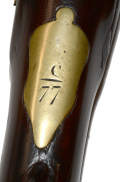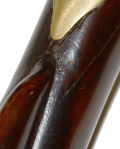site search
online catalog
VERY SCARCE SWAN CONTRACT VIRGINIA MILITIA REGIMENTALLY MARKED MUSKET, CIRCA 1799: COMPANY C, 54th REGIMENT, NORFOLK BOROUGH

$7,500.00
Quantity Available: 1
Item Code: 1000-0255
This musket follows the general lines of a British Short Land Pattern musket, but bears no British maker, ordnance, or proof marks. The lock is a two-screw lock with gooseneck hammer, rounded pan and no external bridle. The lockplate is stamped with raised letters that seem to be addorsed B’s in a rectangular cartouche below the frizzen and just above the screw securing the frizzen spring. The barrel is 42 1/4 inches in length, .69 caliber, and is pin-fastened to the stock, which has a brass nose cap and four ramrod thimbles including a rear entry pipe, elongated first pipe, and the slightly flared second pipe. The brass triggerguard is the British style with recurved bow and acorn finial to the convex forward tang, and is pierced for an absent sling swivel. The wrist bears a British long land style, lobed, brass escutcheon, or thumb plate. The side-plate is the flat elongated S-pattern secured by two screws and the brass butt plate has the short tang, both introduced on British Ordnance arms in 1759. The slightly flared second ramrod pipe was introduced on the 1777 pattern musket (Goldstein and Mowbray, 98-99; 115.)
The stock has elegant proportions, with prominent hand rail in the butt stock and swell in the forestock at the entry pipe. The wood was varnished at some point, but has a good surface with nice warm, reddish brown tone, some minor chips to the edges to the lock apron and some handling dings, but good edges to the side flat and along the barrel. There is a narrow crack on the right wrist coming back from the upper rear of the lock and two short hairlines coming forward from the buttplate, but the wood is stable. The ramrod channel is not chewed up. The nose cap shows an old was repair on the right intended to keep it in place. The buttplate shoulder shows some dings from rough handling and a short crack on the left, likely from hitting the ground too hard in drill. The screws for the frizzen and frizzen spring have been replaced and could be darkened to better match the gun. There are no sling swivels. The ramrod is likely original, or at least a period replacement.
The escutcheon plate is nicely engraved with a “fractional” company letter and rack number: “C/77.” The barrel generally has a smooth brown finish, with front sight in place, but the interior of the pan and breech of the barrel from the touch hole back, on the right and top, show pitting. This obscures the beginning of the engraved barrel inscription, but part of “REGt.” is visible at left and all of “NORFOLK BOROUGH” forward of that.
Virginia contracted for and received two shipments of imported muskets patterned loosely on the British Short Land Musket from James Swan of Boston. Each shipment consisted of 4,000 muskets. The first was contracted for in mid-1797 and received in January 1799. The second was contracted for in Spring 1798 and received in Fall 1800. After some quibbling about quality and pricing, the state paid for 7,831 of the muskets. Specification of the British pattern is not surprising given tensions with France at the time, nor is the use of the Short Land as a pattern: British Ordnance did not direct gun makers to cease making it until 1797 and commercial versions, often mistaken as earlier officer’s fusils, were widely used by British volunteer companies from 1794 to 1804 (Puleo, MAA 41.6.) In any case, subsequent Virginia contracts with other suppliers or makers specified Charleville pattern arms in conformity with those then produced at the national armories.
Whether this is from Swan’s first or second contract is unclear and depends on identification of the lock marking: muskets of Swan’s first contract were made in Liege and those of the second in a northern German state, perhaps Hamburg. In both cases, however, European cottage industry probably dictated manufacture of locks by a number of smaller makers supplying Swan’s subcontractors or agents. We note that this one lacks an external bridle for the pan, where some other Swan contract guns have it.
The “Norfolk Borough” barrel marking makes it certain the regimental designation is the 54th Virginia Regiment of militia. Norfolk County fielded the 7th and 95th Regiments, but Norfolk Borough fielded only the 54th in both 1800 and 1820 tables of organization (Cromwell, Va. Mfry. 157-162.) A slightly later parallel for the marking is an 1812-dated Virginia Manufactory musket (Julia Auction 10/2017) with the stamped barrel marking, “54 VA REGT NORFOLK BOROUGH.” Engraved barrel designations, however, are also known and two show up on Swan muskets: “10 Va REGt BEDFORD” (Cromwell, VA. Mfry., p. 3;) and a Confederate conversion of a Swan musket engraved on the barrel for Orange County, pictured in “Conf. Rifles & Muskets,” and which we are also offering.
The 54th regiment seems to have had the usual mix of enrolled militia and uniformed volunteer companies. The latter included an artillery and cavalry company, and at points at least two of the infantry companies: the “Juniors” and the “Independents” (the latter formed from men in the regiment in June 1812.) A May 1794 account of the annual militia muster in Norfolk (Haarman, MCH 32.3 (Fall 1980) 113-115) notes, “Most of the companies were ununiformed, poorly armed and untrained; some wear uniforms which are blue with red collar and trimmings. The general uniform is green with white buttons…” It is possible this musket, with nicer architectural design and the inscribed escutcheon plate, belonged to one of the uniformed companies, but the regimental designation on the barrel clearly indicates it was state property in any case.
The regiment seems to have done some duty at Fort Norfolk, which was only intermittently garrisoned as a Federal facility from 1794 to 1804, and then again from 1807 as tensions with Britain rose. According to Forrest’s history of Norfolk, during the war of 1812, “the 54th regiment, Norfolk Borough, was frequently called out, en masse, for brief periods…” This included a six month tour starting in February or March 1813 and lasting into August. The Virginia military commander of the area mentions using 280 militia men to entrench the approaches to the Borough in March. In June they did not participate directly in the repulse of the British at the Battle of Craney Island, but a detachment is known to have guarded British prisoners. They were called up again in 1814 as the British moved against Baltimore and Washington. The regiment was officially to be kept in reserve, but the volunteer companies joined a large force of 3-4,000 militia gathered by the Governor in the area and 100 men were later drafted to serve in a composite militia regiment. With the attack on Washington, however, the entire regiment was again called up “en masse,” serving for about two months, into late October.
This is a nice looking musket that illustrates some of Virginia’s efforts to arm its citizen soldiers in the years following the Revolution. It has a tight connection to the 54th Regiment and to Norfolk as well. Virginia marked weapons are a collecting category of their own. This displays very well and would make a nice addition to a collection. [sr] [ph:L]
DISCLAIMER: All firearms are sold as collector's items only - we do not accept responsibility as to the shooting safety or reliability of any antique firearm. All firearms are described as accurately as possible, given the restraints of a catalog listing length. We want satisfied customers & often "under" describe the weapons. Any city or state regulations regarding owning antique firearms are the responsibility of the purchaser. All firearms are "mechanically perfect" unless noted, but again, are NOT warranted as safe to fire.
~~~~~~~~~~~~~~~~~~~~~~~~~~~~~~~~~~~
THIS ITEM, AS WITH ALL OTHER ITEMS AVAILABLE ON OUR WEB SITE,
MAY BE PURCHASED THROUGH OUR LAYAWAY PROGRAM.
CLICK HERE FOR OUR POLICIES AND TERMS.
THANK YOU!
Inquire About VERY SCARCE SWAN CONTRACT VIRGINIA MILITIA REGIMENTALLY MARKED MUSKET, CIRCA 1799: COMPANY C, 54th REGIMENT, NORFOLK BOROUGH
For inquiries, please email us at [email protected]
Most Popular
Historical Firearms Stolen From The National Civil War Museum In Harrisburg, Pa »
Theft From Gravesite Of Gen. John Reynolds »
Selection Of Unframed Prints By Don Troiani »
Fine Condition Brass Infantry Bugle Insignia »
British Imported, Confederate Used Bayonet »
Scarce New Model 1865 Sharps Still In Percussion Near Factory New »
featured item
WORLD WAR TWO / KOREA UNITED STATES MARINE CORPS OFFICER’S MAMALUKE SWORD
The drawn sword meas. approx. 36.00 inches long. The blade itself meas. approx. 31.00 inches long x 0.75 of an inch wide at the ricasso. It has a central fuller that starts just above the ricasso and runs for approx. 27.00 inches. The blade surface… (2021-944). Learn More »
site search
Upcoming Events
May 16 - 18: N-SSA Spring Nationals, Fort Shenandoah, Winchester, VA Learn More »


























